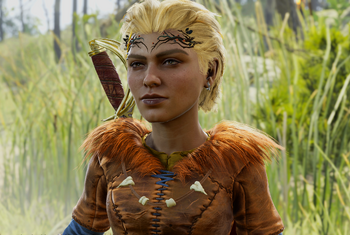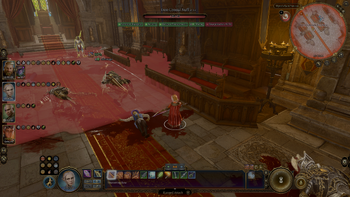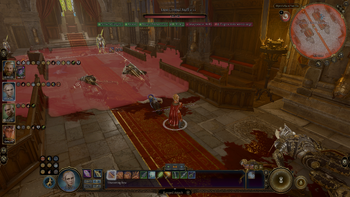Guide:Stealth fighting
This is a user-operated guide, and follows different guidelines from the rest of the wiki. Ask the user before editing this page. Leave feedback on the Discussion page. |
Purpose[edit | edit source]
Stealth can be used to shape, ease, and - in many cases - avoid formal turn-based combat. This is typically accomplished through crowd control and object placement to either eliminate foes or enfeeble them to a state of near total defeat. Although stealth-based fighting has utility in many situations and at all difficulty levels, it is of particular use in Honour mode, where (for example) certain mistakes, bad rolls, or unforeseen events can lead to a Game Over.
Some examples of stealth-based fighting making things easier with Bosses include:
- Picking off the Phase Spider Matriarch and her minions out of turn-based combat in Act One
- Picking off Flind's companions, and possibly Flind herself, out of turn-based combat in Act One
- Prepping for the first fight with Ketheric Thorm on the rooftop of Moonrise Towers in Act Two
- Killing Ketheric and his allies in the Mind Flayer Colony in preparation for the fight with the Apostle of Myrkul
- Avoiding a formal turn-based fight with Lorroakan by sniper shooting him to death in Act Three
- Picking off Viconia's associates, and possibly Viconia herself, prior to a turn-based fight with her in the House of Grief
- Picking off Gortash's associates, and possibly Gortash himself, prior to a turn-based fight with him in his office on the top floor of Wyrm's Rock Fortress
- Picking off Cazador's minions in his dungeon
This guide assumes the party has a minimum level of 3.
Desired things[edit | edit source]
Classes[edit | edit source]
While any Rogue class is well suited for stealth fighting due to their typically high Dexterity, four skill proficiencies, ability to select Expertise in stealth at level 1, acquisition of Reliable Talent at level 11, and their sneak attack ability, thieves are usually the best overall choice due their additional Bonus Action at level 3, allowing for greater flexibility and control of the field in turn-based mode.
[edit | edit source]
First and foremost Advantage is of paramount importance for stealth fighting[1] out of combat. This is because, as duly noted on the Hide page, if a player character attacks while hiding: the character's Stealth check to remain unnoticed has Disadvantage by default and can be cancelled out by any source of Advantage for the check. So, if you've ever felt like stealth-based attacks have been stacked against you this may be why.
The methods to acquire advantage and other below conditions are best obtained obtained from casting by another party member due to their Concentration requirements (yet also see equipment below):
- Blessing of the Trickster or the Cat's Grace variant of Enhance Ability for Advantage on stealth checks while hiding
- Invisibility and, when available, its Greater Invisibility variant[2]
- Although this requires a College of Valour Bard in the active party, Combat Inspiration can be useful for moments where a little extra help can make all the difference
- Bless
- The Minor Illusion cantrip, for crowd control[3]
[edit | edit source]
In total, the below items add Advantage and an average of +18 to all stealth checks (not including Dexterity)
- Leather Armour +1 or better versions, once they become available, for their +1 to stealth checks
- The Deathstalker Mantle - useful for free invisibility in certain circumstances (only available in Dark Urge playthroughs)
- Gloomstrand Shield - if the wielder is proficient with shields, useful for its +1 to stealth
- The Graceful Cloth - recommended for non-halflings above other armours once available due to advantage on Dex checks and its +2 to Dex (up to 20)[4]
- Nimblefinger Gloves - +2 to Dexterity if the wearer is a gnome or disguised as one[5]
- Ring of Shadows - for the +10 stealth to its wearer (requires concentration)
- Shapeshifter's Boon Ring - for +1d4 to all skill checks
- Silver Pendant - +1d4 to all skill checks (once the Ring of Shadows is acquired, its Bless must be cast by another party member)
- Smuggler's Ring - +2 to stealth (can replace the Shapeshifter's Boon Ring after its benefits are applied)
[edit | edit source]
Amoung other benefits, the below items can add up to +5 to the chance to critically hit (rolling 15 or higher on a d20)
- Assassin's Shortsword - useful for non-halflings until The Graceful Cloth is available for its advantage to stealth checks
- Bloodthirst - preferred in the second hand over the Gloomstrand Shield[6] once available for its bonus to critically hit
- Bonespike Gloves - preferred once available for dealing with enemies resistant to piercing damage (e.g. Steel Watchers)
- Knife of the Undermountain King - preferred once available for its bonus to (critically) hit and the user has The Graceful Cloth, no longer needing the Assassin's Shortsword
- Marksmanship Hat - for +1 to hit[7]
- Punch-Drunk Bastard - useful for (ranged) attacks with Advantage if not hiding
- Sarevok's Horned Helmet - preferred over other helmets once available for its boost to critically hit and immunity to Frightened
- Shade-Slayer Cloak - preferred once available for its boost to critically hit while hiding (probably most of the time)
- Titanstring Bow - if one's odds to hit are high enough, useful in conjunction with Elixir of Hill Giant Strength or Elixir of Cloud Giant Strength - When used together with a 20 dexterity, these items can add up to 13 damage (5 from dex, 8 from str), plus whatever sneak attack and other sources may apply.
- The Dead Shot - preferred over other bows once available, for its boost to (critically) hit
[edit | edit source]

- Astarion is the logical choice to start with for stealth fighting due to his Happy condition. However once the character's stealth ability gets high enough and / or if one is concerned about critical failures (especially stealing in Honour mode), Lightfoot Halflings eventually make more sense due to their Halfling Luck passive. They also get Advantage on Stealth checks and saves against fear. Halflings can be hired from Withers as early as level 3.
- Archery - is helpful for its +2 to hit
- Lucky - can be useful where failure has particularly unfortunate results or, conversely, success is deemed essential[8]
- Sharpshooter: All In and Sharpshooter: Low Ground eliminate low ground penalties and allow the sniper to add +10 damage once their attack probabilities are high enough for their chosen targets
- Sneak Attack (Ranged) - their average added damage of +3.5 at every odd level is the main reason high-level Rogues are likely of more utility than other classes while stealth fighting out of proper turn-based combat[9]
Other items[edit | edit source]
- Potions of Invisibility - can be consumed with only a Bonus Action as needed
Methods, Tactics and Reasoning[edit | edit source]
In many cases, in the interest of safety and flexibility, sniper-fighting will be the preferred method of dispatching foes. The surprise page explains:
- If a character's Stealth is high enough then enemies will sometimes fail to notice them even as their allies are being attacked and killed from a distance. This can even work with Area of Effect spells such as Fireball as long as the party member casting it remains hidden. The enemies will run around in a desperate search for the party member but be unable to find them. This can be accomplished with a high Dexterity score, Proficiency and Expertise in stealth, Advantage in dexterity or stealth checks, and certain spells and abilities such as Pass Without Trace.


When sniper-fighting opponents, the goal is to defeat or weaken them in turn-based mode, but out of formal turn-based combat mode. For sneak attack damage to apply with ranged attacks while avoiding the possibility of starting formal combat, all ranged attacks must be done while hiding and very near the end range of the ranged weapon's normal range.
Specifically, the High ground rules page states:
- A ranged weapon's 'maximum effective range' is its 'normal attack range'. Beyond this, the attacker suffers a 'Target outside normal range' penalty which applies Disadvantage to the attack roll. Unlike attack range abilities, this effective range is *not* extended by the high ground range extension. It is also measured using the true distance between the attacker and target, not just the horizontal component. Thus, maximum attack range and effective weapon range are equal at level elevations, but diverge when dealing with elevation 'differences'. Practically speaking, this means this penalty is only encountered when extending the attack range with elevation, particularly high ground range extension. Spell attacks do not have a maximum effective range and do not suffer this penalty when attacking beyond normal range.
Acting alone, to the extent that thieves fight sniper-style using the above desired things, they have increasingly good odds of sneak attacking opponents at their weapon's maximum normal range, typically with respectable (if not excellent) chances of hitting, while successfully maintaining stealth and / or Greater Invisibility until their chosen foes are dead. In doing so, the thief is advised to take care to first trim opponents at the periphery of a targeted area with many lines of sight, then work their way in to avoid starting an unwanted fight.
Consequences[edit | edit source]
Constantly stealth-fighting can be a tedious affair. It requires preparation/planning and repetition, as well as careful placement and action far away from the rest of the active party to isolate combat when things go wrong, as they inevitably will (although the goal, of course, is to greatly reduce these odds). It is also considerably riskier in honour mode. Additionally, doing this much of the time will significantly slow the pace of the game, and is considered cheesing by many. Still, the primary goal of making many battles considerably easier, or (by most practical measures) avoiding them altogether, is quite tenable as a result.
In conclusion, if you've read this far, and especially if you're playing in Honour mode, where Larian feels free to throw everything they have at you - and more, the above tactics and equipment are viable paths to victory and - ultimately - golden dice.
Notes and references[edit | edit source]
- ↑ Lightfoot Halflings already have Advantage on stealth checks.
- ↑ Actions with the
Invisibleflag can be performed without this Stealth check. They also do not increase the Stealth check DC of subsequent actions.- Outside of Honour mode, the DC of maintaining (greater) invisibility scales linearly:
- In Honour mode, the DC scales quadratically:
- If one plans to use greater invisibility while in honour mode, it's advisable to have this spell re-cast after perhaps 3 to 4 attacks to avoid unwanted spell failure in what could become dire circumstances.
- ↑ It is difficult to overstate the utility of Minor Illusion for luring and / or distracting foes to more secluded areas to rob or kill desired targets, making a single level in Bard, Sorceror, Warlock or Wizard, an attractive option, especially in Honour Mode.
- ↑ The +2 Dexterity from The Graceful Cloth stacks with the same from the Mirror of Loss, raising the wearer's from 18 to 22.
- ↑ The +2 Dexterity from Nimblefinger Glove stacks with the same from the Mirror of Loss, raising the wearer's from 20 to 24.
- ↑ By the time the player character gets Bloodthirst they're likely a level 11 or 12 rogue, have Reliable Talent and therefore arguably less need for the +1 stealth the Gloomstrand Shield provides.
- ↑ Once the user has a high enough attack value, other headwear such as Covert Cowl or Sarevok's Horned Helmet are likely more useful than the +1 to hit from the Marksmanship Hat.
- ↑ As a level 11 rogue / level 1 fighter is a strong combination once the player character attains level 12, such a build will have 3 feats. It is suggested the player consider these three for such a build: Ability Improvement (to bring Dex from 17 to 19) Sharpshooter (for sniper firepower), and either Athlete (to bring Dex to 20) or Lucky (if playing in Honour mode, in which case base Dex should be 16, not 17). Such a build is not intended for the purposes of this guide to be used in regular turn-based combat, where Alert would otherwise be essential in Honour Mode.
- ↑ While exceptions surely exist to this rule of thumb, it's usually a good idea to maximize sneak attack damage to speed up the already slow process of sniper-killing. A level 11 Thief/ level 1 Fighter with the archery fighting style makes for a good level 12 combo, as does a level 11 Thief / level 1 Bard.